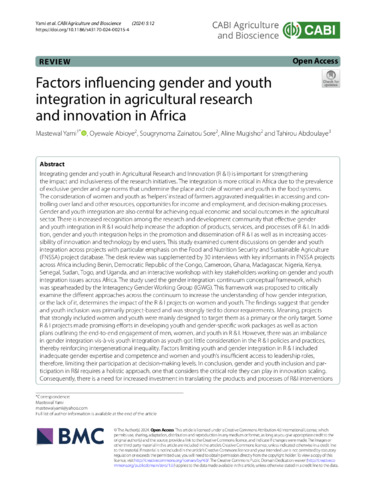Factors influencing gender and youth integration in agricultural research and innovation in Africa
Abstract
Integrating gender and youth in Agricultural Research and Innovation (R & I) is important for strengthening the impact and inclusiveness of the research initiatives. The integration is more critical in Africa due to the prevalence of exclusive gender and age norms that undermine the place and role of women and youth in the food systems. The consideration of women and youth as ‘helpers’ instead of farmers aggravated inequalities in accessing and controlling over land and other resources, opportunities for income and employment, and decision-making processes. Gender and youth integration are also central for achieving equal economic and social outcomes in the agricultural sector. There is increased recognition among the research and development community that effective gender and youth integration in R & I would help increase the adoption of products, services, and processes of R & I. In addition, gender and youth integration helps in the promotion and dissemination of R & I as well as in increasing accessibility of innovation and technology by end users. This study examined current discussions on gender and youth integration across projects with particular emphasis on the Food and Nutrition Security and Sustainable Agriculture (FNSSA) project database. The desk review was supplemented by 30 interviews with key informants in FNSSA projects across Africa including Benin, Democratic Republic of the Congo, Cameroon, Ghana, Madagascar, Nigeria, Kenya, Senegal, Sudan, Togo, and Uganda, and an interactive workshop with key stakeholders working on gender and youth integration issues across Africa. The study used the gender integration continuum conceptual framework, which was spearheaded by the Interagency Gender Working Group (IGWG). This framework was proposed to critically examine the different approaches across the continuum to increase the understanding of how gender integration, or the lack of it, determines the impact of the R & I projects on women and youth. The findings suggest that gender and youth inclusion was primarily project-based and was strongly tied to donor requirements. Meaning, projects that strongly included women and youth were mainly designed to target them as a primary or the only target. Some R & I projects made promising efforts in developing youth and gender-specific work packages as well as action plans outlining the end-to-end engagement of men, women, and youth in R & I. However, there was an imbalance in gender integration vis-à-vis youth integration as youth got little consideration in the R & I policies and practices, thereby reinforcing intergenerational inequality. Factors limiting youth and gender integration in R & I included inadequate gender expertise and competence and women and youth’s insufficient access to leadership roles, therefore, limiting their participation at decision-making levels. In conclusion, gender and youth inclusion and participation in R&I requires a holistic approach, one that considers the critical role they can play in innovation scaling. Consequently, there is a need for increased investment in translating the products and processes of R&I interventions into opportunities for entrepreneurship and employment. Intersectional lens is also needed for meaningful involvement of different community groups in the R&I interventions, and for reducing the different causes of inequalities and marginalization that hamper transformation of Africa’s food system. This could be an entry point for increasing the positive impact of R & I projects on livelihoods, gender equality, women’s empowerment, and entrepreneurship.

